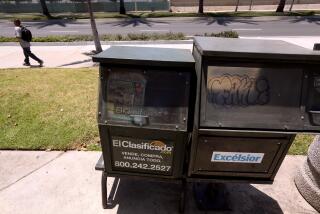California Endowment broadens ambitions and narrows scope
As the head of the California Endowment, the state’s largest healthcare foundation, Robert Ross wields the kind of political power that comes with giving away $165 million a year. A pediatrician by training, Ross has delved into issues as varied as childhood obesity, prison reform and the future of the beleaguered Charles R. Drew University of Medicine and Science.
But what has made Ross, 56, into a powerful force in California philanthropy is not just the money he gives away: it’s his approach to big-ticket giving that his organization has made a central part of its mission.
By nurturing nascent community efforts, funding pilot projects and partnering with local groups and other charities in ways that government once did before budget problems began to curtail the social net, the endowment is functioning as a social incubator, hoping that its initial investment will pay dividends for years to come.
As a result, Ross and the endowment are at the forefront of an effort to rethink how to keep California children healthy, and their influence is shifting the way in which philanthropies and charities throughout the state function.
At a moment when all sectors of society are reeling from economic problems, when government is making deep cuts to its health and welfare programs, there is an expectation that wealthy foundations such as the California Endowment can step in and somehow mend the state’s tattered social fabric.
In truth, foundations do not have the resources to make such changes alone; their annual giving equals only a small percentage of the state budget.
But Ross, who headed public health departments in Philadelphia and San Diego before arriving to lead the endowment in 2000, is trying to use his organization’s financial and political capital to drive the kind of simple changes that he considers key to transforming California’s poorest neighborhoods.
In Santa Ana, that means pushing for the installation of new mailboxes in the Townsend Raitt area, where unsecured and broken boxes meant that bills went unpaid and important information was not delivered. In San Diego, that means helping fund a community garden that has been a source of hope and sustenance for residents of the City Heights neighborhood. In South Sacramento, it means arranging free diabetes and dental screening for residents.
All of those events were accomplished in cooperation between the endowment and local nonprofits and are part of a new campaign the part of by the foundation. Two years ago, the California Endowment announced that it was shifting the focus of its grants. The group, which had long preferred generally short-term, project-based giving, was moving to a much deeper, longer term commitment known as place-based giving.
The statement sent a ripple through the region’s philanthropic community. Other foundations have done place-based giving before, experts say. But none has attempted it on such a scale, or with such an emphasis on how to measure the results.
“This is pretty sophisticated stuff,” said Angela Glover Blackwell, founder and chief executive officer of PolicyLink, a national research and action institute. “It’s pretty bold.”
Over the next 10 years, the endowment’s Building Healthy Communities initiative will commit most of the organization’s grant-giving funds — hundreds of millions of dollars — to 14 specific California communities, including Boyle Heights, the South Figueroa corridor and East Oakland. The initiative’s goal is to improve the lives and health of people in those communities — but each community has targeted different ways of doing that.
Making such a rich, deep investment in ending poverty and improving health is what Blackwell calls “a big idea.” She said that philanthropists and policymakers are keeping a close eye on whether the endowment can have the kind of lasting success in those 14 California communities that has eluded others.
Ross has garnered his share of praise for what many see as a fresh approach to Los Angeles problem-solving.
Elise Buik, president and chief executive officer of United Way of Greater Los Angeles, who often partners with the endowment, praised Ross’ leadership. “What he has been able to bring to philanthropy,” she said, includes “a recognition of the importance of public-private partnerships.”
Ross’ style of leadership, she added, “had a ripple effect beyond the endowment.”
Although their influence may be profound, Ross and the endowment have also been frequently criticized for being too slow to respond to pressing issues. Sometimes the organization’s moves can seem over-calculated. And when it wades into political thickets, it has drawn anger from elected officials who feel that it is equipped with cash but not a deep understanding of the issues.
Connie Rice, co-director of the Advancement Project, said that when Ross arrived in Los Angeles from San Diego in 2000, it was clear “he didn’t understand L.A.” — in particular, the region’s complexities and the scope of its problems.
But she said that she has watched as Ross became a student of the vast metropolis, seeking out community and business leaders to guide him. And she said that the moves he is making to shift the endowment’s mission reflect what he has learned and what Los Angeles needs.
“Most foundations want to do some nice little safe pilot project that they can give a plaque out for,” Rice said. But Los Angeles, she added, “is too complex, our problems are too big for that. He’s doing place-based intervention, pegged at the transformative level.”
“If you change the endowment,” she added, “you change California philanthropy.”
The California endowment was created in 1996 after the nonprofit Blue Cross of California became a new for-profit company. As part of its deal with the state of California, the new corporation gave $900 million cash to fund the endowment, which strives to expand access to affordable, quality healthcare.
The endowment annually gives out about 5% of its worth. Last year, that meant $165.8 million in grants.
Ross knows that money is meager given the problems in the state, which he says has a huge to-do list. The system, he said, is not working. The middle class is disappearing. The health of children is suffering. The state’s poorest neighborhoods “are in the cauldron of these issues of lousy schools, unemployment, violence.”
The Building Healthy Communities initiative is a chance to right at least some of those ills — or at least try. Foundation money is being used to combat childhood asthma and obesity, fix up local parks to make them safer and cleaner; build fitness centers in unused spaces; create neighborhood gardens and provide better access to preventive medical care, among other things.
The last few years have not been easy at the endowment. The financial downturn took away 30% of the endowment’s worth — though some has been regained. And a staff restructuring, brought on in part by the need to shift job responsibilities for the new community-focused initiative, meant that 40 of its 150 employees left the foundation or were offered buyouts.
But the financial downturn has also brought the endowment into closer partnerships with local governments, which have been hit by their own budget problems because of the recession.
“This time of crisis has helped bring us all together in new ways,” said Aileen Adams, Los Angeles’ deputy mayor in charge of the Office of Strategic Partnerships, half of which is funded by foundation money.
The government “doesn’t have as much free resources,” said James Ferris, the Emery Evans Olson Chair in Non-Profit Entrepreneurship and Public Policy and director of the Center on Philanthropy and Public Policy at USC. “There’s a lot of interest in looking at partnerships between foundations and government working together to solve problems,” he said.
Whether it’s the county health department asking the California Endowment to assist with writing a grant for federal stimulus dollars or nonprofit groups encouraging their constituents to claim food stamps or earned income tax credits, the goal is for a “multiplier effect,” said Sushma Raman of Southern California Grantmakers.
Ross sees the partnerships as part of the solution to improving communities, with private and public helpers working for common goals. But he also sees key difference in the two roles. While the government provides basic service, the endowment is focusing more on longer-term programs that can ultimately make the communities more self-sufficient, including a focused push toward creating green jobs in each of the 14 targeted neighborhoods.
“The paradigm shift is that rather than viewing these communities as supplicants waiting for a white knight to come in to save them,” Ross said, “they actually have the creativity and the energy. The answers and problem-solving have to come from these communities up, and .... they will demonstrate the problem-solving behavior that Sacramento and Washington need to learn from, rather than the other way around.”
The initiative, he said, “wasn’t an experiment. It wasn’t a pilot. The bottom line of why disinvested communities struggle is not an innovation problem. It’s a power problem.”
More to Read
Sign up for Essential California
The most important California stories and recommendations in your inbox every morning.
You may occasionally receive promotional content from the Los Angeles Times.










